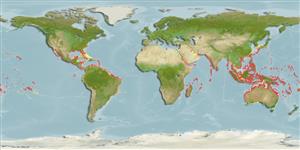Common names from other countries
Environment: milieu / climate zone / depth range / distribution range
Ecologia
; intervalo de profundidade 5 - 30 m (Ref. 349). Tropical
Indo-Pacific and Western Central Atlantic.
Length at first maturity / Tamanho / Peso / Idade
Maturity: Lm ? range ? - ? cm Max length : 8.0 cm ShH macho/indeterminado; (Ref. 349); common length : 6.0 cm SHL macho/indeterminado; (Ref. 349)
Incidentally collected in fish traps and trawls, where common (Ref. 349). On fine sandy bottoms (Ref. 349). Dead shells found on the beaches (Ref. 88739).
Life cycle and mating behavior
Maturidade | Reprodução | Desova | Ovos | Fecundidade | Larvas
Members of the order Neotaenioglossa are mostly gonochoric and broadcast spawners. Life cycle: Embryos develop into planktonic trocophore larvae and later into juvenile veligers before becoming fully grown adults.
Poutiers, J.M. 1998. (Ref. 349)
Status na Lista Vermelha da IUCN (Ref. 130435)
Status no CITES (Ref. 108899)
Not Evaluated
Not Evaluated
Perigo para os humanos
Harmless
Uso pelos humanos
| FishSource |
Ferramentas
Mais informação
Idade/TamanhoCrescimentoComprimento-pesoComprimento-comprimentoMorfologiaLarvasAbundância
Fontes da internet
Estimates based on models
Preferred temperature
(Ref.
115969): 24.2 - 29.2, mean 28 (based on 4541 cells).
Vulnerabilidade
Low vulnerability (10 of 100).
Categoria de preço
Unknown.
